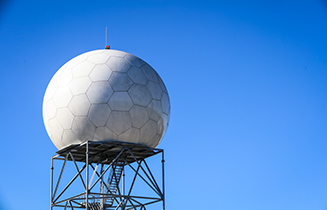
On Easter Sunday, in the midst of the COVID-19 crisis, an EF-3 tornado with winds of about 140 mph struck the Monroe/West Monroe area causing destruction around Northeastern Louisiana. There were also two tornadoes that struck the Sterlington area, an EF-2 and EF-1.

The National Weather Service (NWS) in Shreveport credits the University of Louisiana Monroe Doppler radar with providing critical data which led to additional lead-time on alerts and alarms to warn the residents of Monroe and West Monroe and the surrounding area about the tornados.
Todd Murphy, Ph.D., Assistant Professor in Atmospheric Science was in communication with the NWS throughout the entire severe weather event ensuring the radar was scanning in a manner that helped their operations.
The NWS Shreveport issued the first tornado warning that included Monroe at 11:33 a.m. on Sunday, April 12 based on a radar detected surge in the line of thunderstorms. One minute later the rotation increased on the ULM radar, and a “tornadic debris signature” was detected on the ULM radar at 11:36 a.m.
Just a few minutes later the tornado touched down in the Brownsville - Bawcomville community and moved to the City of West Monroe damaging many homes. It then crossed the Ouachita River onto South Grand Street and impacted neighborhoods as well as the Masur Museum of Art.
It crossed near the intersection of Highway 165 and I-20 damaging structures and wooden power poles as it continued north of Millhaven Road then on to the Monroe airport causing severe damage at the airport and nearby neighborhoods.
Because of the additional lead-time for alerts and alarms to warn members of the Northeast Louisiana community to seek shelter, the ULM Doppler radar played a crucial role in the detection of the Monroe tornado and likely saved lives on Sunday.
“The ULM Doppler weather radar was built specifically to close a low-level data gap within the national radar network, and it has time and again provided invaluable data to the National Weather Service to assist in the issuance of local severe weather warnings. We work closely with NWS meteorologist to ensure they receive timely and accurate data from our radar. In addition to this great service, the radar is used both in research and teaching, providing students a unique hands-on learning experience only available at some of the top atmospheric science programs in the country,” stated Murphy.
Less than a year ago, ULM Doppler radar was credited for helping save lives with advance detection of the tornado which struck Ruston on April 25, 2019.
ULM installed the Doppler radar in October 2016 using a $3 million grant provided by the Louisiana Governor’s Office of Homeland Security and Emergency Preparedness (GOHSEP). ULM is the only primarily undergraduate institution in the United States with a S-band polarmetric Doppler weather radar. ULM students receive hands-on instruction at the undergraduate level on radar operation, in addition to advanced radar analysis and interpretation techniques.